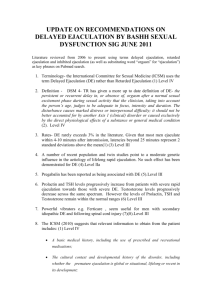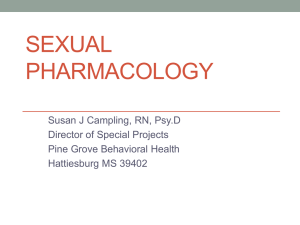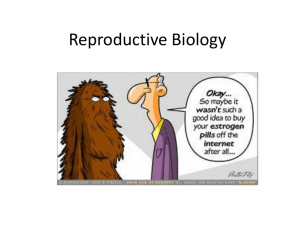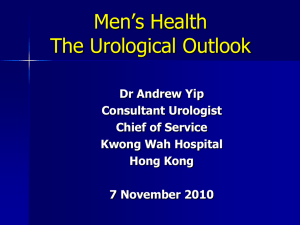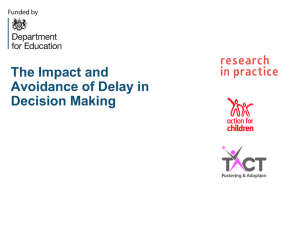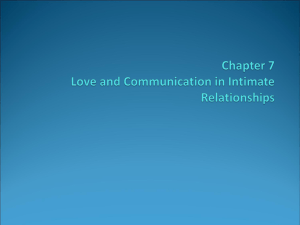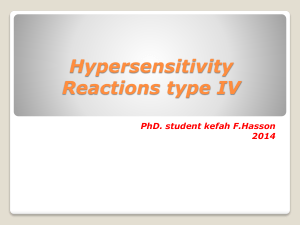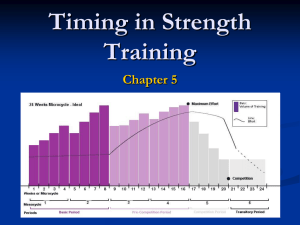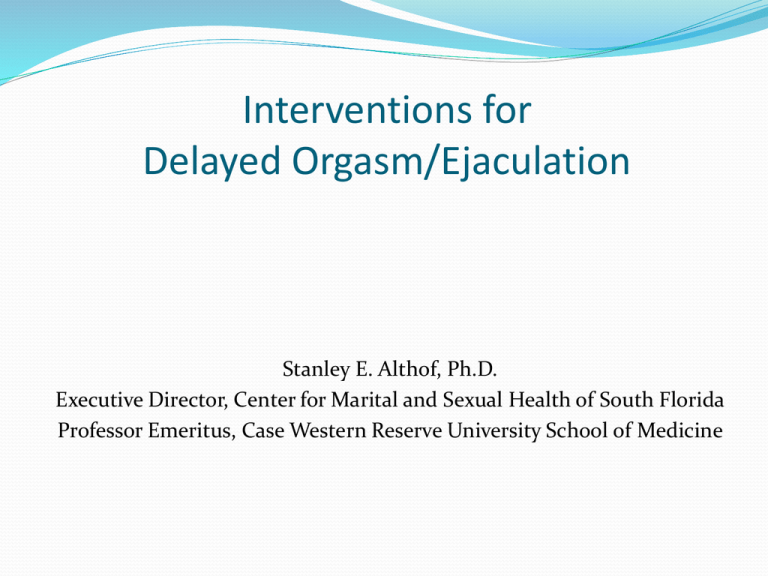
Interventions for
Delayed Orgasm/Ejaculation
Stanley E. Althof, Ph.D.
Executive Director, Center for Marital and Sexual Health of South Florida
Professor Emeritus, Case Western Reserve University School of Medicine
Spectrum of Ejaculatory Disorders
Delayed
Ejaculation
Anejaculation
“Normal”
Ejaculation
Retrograde
Ejaculation
Perelman et al, Atlas of Sexual Dysfunction, 2004
Premature
Ejaculation
Clarifying the Terms Ejaculation and Orgasm
“Ejaculation and orgasm usually occur simultaneously in
men, even though they are two separate phenomenon.
Ejaculation occurs in the genital organs whereas
orgasmic sensations, being related to the genitals, are
mainly a cerebral event and involve the whole body.”
Waldinger, MD & Schweitzer D., World Journal of Urology, 2005, 23: 76-81
Prevalence
Well conducted large scale prevalence studies are lacking
Subjective and vague definition of the dysfunction poses a
problem for objective identification of men suffering from
the disorder
Lifelong delayed ejaculation is a relatively uncommon
condition in clinical practice
The prevalence of DE in men below 65 years is 3-8%
Men’s complaints of DE appear to be increasing
Nathan, SG., Journal of Sex and Marital Therapy, 1986, 12: 267.
Spector, I & Carey, M., Archives of Sexual Behavior , 1990, 19: 389-408.
Ejaculatory Disorders in Elderly Males (n=1.455)
Ejaculatory/Orgasmic
Disorder
57– 65 years
65 – 74 years
75–85 years
Premature Ejaculation
29.5%
28.1%
21.3%
Anejaculation
16.2 %
22.7 %
33.2%
Lindau,S.T. et al, New England Journal of Medicine, 2007, 357: 762-774
Inconsistent Nomenclature
All these terms describe a delay or absence of ejaculation/orgasm
Anejaculation
Delayed ejaculation
Difficult ejaculation
Ejaculatio retardata
Ejaculatio deficiens or nulla
Ejaculatory incompetence
Idiopathic anejaculation
Impotentia ejaculandi
Inhibited ejaculation
Inadequate ejaculation
Late ejaculation
Male orgasmic disorder
Partner anorgasmia
Primary impotentia ejaculations
Psychogenic anejaculation
Retarded ejaculation
It is axiomatic that the more names we
have for a dysfunction the less we
know about it!!!
DSM IV-TR Definition of
Male Orgasmic Dysfunction (302.74)
A. Persistent or recurrent delay in, or absence of, orgasm
following a normal sexual excitement phase during
sexual activity that the clinician, taking into account the
person’s age, judges to be adequate in focus, intensity and
duration.
B. The disturbance causes marked distress or interpersonal
difficulty.
C. The orgasmic dysfunction is not better accounted for by
another Axis I disorder and is not due exclusively to the
direct physiological effects of a substance or a general
medical condition.
American Psychiatric Association. Diagnostic and Statistical Manual of Mental Disorders, 4th Edition, Text
Revision. Washington, DC: American Psychiatric Association; 2000.
DSM-IV-TR Specifiers for Delayed Ejaculation
• Lifelong vs. Acquired
• Global vs. Situational
• Due to psychological or combined psychological and
biological factors
American Psychiatric Association. Diagnostic and Statistical Manual of Mental Disorders,
4th Edition, Text Revision. Washington, DC: American Psychiatric Association; 2000
Normative IELT Data
Population based study of 500 heterosexual couples in the Netherlands, United
Kingdom, Turkey and Spain. Subjects used a stopwatch to time their
intravaginal ejaculatory latency time (IELT)
100
•
Percentage of subjects
90
80
•
70
60
50
Median stopwatch IELT of 5.4 minutes
(range, 0.55 - 44.1 min.)
Using an epidemiological approach to
assess DE risk, men with an IELT >
2SD above mean (~25 min) have DE
40
30
20
10
0
0
200
400
600
800 1,000 1,200 1,400 1,600 1,800 2,000 2,200 2,400 2,600 2,800
Mean IELT (s)
Waldinger et al. (2005) Journal of Sexual Medicine 2:492–497
Hypothalamus
+
Dopamine
EJACULATION
-
Serotonin
Causes of Delayed Ejaculation, Anejaculation and Anorgasmia
Male Aging
Degeneration of afferent neurons and paccinian corpuscles
Psychological
Insufficient stimulation, atypical masturbation, conflict and
disguised desire disorder
Congenital
Mullerian duct cyst, Wolfian duct abnormality, Prune belly
syndrome
Anatomic
TURP, bladder neck incision
Neurogenic
Diabetic autonomic neuropathy, SCI, RP, proctocolectomy,
Bilateral sympathectomy, abdominal aortic aneurysmectomy,
para-aortic lympthadenectomy
Infective
Urethritis, genitourinary TB, schistosomiasis
Endocrine
Hypogonadism, hypothyroidism
Medication
SSRIs, SNRIs, Alpha-methyl dopa, thiazides, α-blockers
phenothiazines, alcohol
Negative Psychological Consequences
of Delayed Ejaculation
Impact of DE on the patient and partner is often not fully appreciated
Some perceive DE to be a positive attribute that allows the man to
“bestow multiple coital orgasms to his partner”
DE is involuntary and causes distress for both the man and the
partner
Partners believe they are not attractive enough for the patient. They
feel unneeded and rejected.
Extended coitus causes pain for the patient and partner
Anejaculation results in a failure to conceive
Delayed Ejaculation, Anejaculation and Anorgasmia
FAILURE OF EMISSION
NEVER
IS THERE
ORGASM?
•Neurogenic
•Metabolic
•Drug Adverse Effect
Disease Specific
Management
INHIBITED MALE ORGASM
SOMETIMES
•Nocturnal/Masturbation
Emissions
Psychosexual therapy
AGE-RELATED
DEGENERATION
Reassure/alter sexual
technique
Courtesy of Col. Robert Dean
ALWAYS
IS THERE EJACULATION?
Psychogenic Delayed Ejaculation
Variability is the hallmark of psychogenic delayed
ejaculation
Orgasm/ejaculation occurs via masturbation or
nocturnal emission but not with a partner
May occur with the partner during foreplay but not
intercourse
Four Diverse Psychological Theories
All Without Empirical Support
Insufficient Stimulation
Failure to achieve sufficient mental
or physical stimulation
Masturbation
High frequency of masturbation
Idiosyncratic masturbatory style
Disparity between fantasy & reality
Delayed Ejaculation
Outgrowth of Psychic Conflict
Loss of self from loss of semen, fear of harm
from female genitals, fear that ejaculation
may hurt the partner, fear of impregnating
the female, fear of defiling the partner with
semen, hostility toward partner, not willing
to give of oneself, guilt from strict religious
upbringing
Disguised and Subtle Desire
Disorder Masquerading as an
Ejaculatory Dysfunction
Automatic functioning in the absence of
genuine arousal, autosexual orientation,
partner’s touch inhibiting, penis becomes
insensate, compulsion to satisfy partner
Delayed/Anejaculation
Courtesy of Chris McMahon
Maximise arousal
Prolong & intensify foreplay
Use of fantasy
Vibrator stimulation
Four Diverse Psychological Theories
All Without Empirical Support
Insufficient Stimulation
Failure to achieve sufficient mental
or physical stimulation
Masturbation
High frequency of masturbation
Idiosyncratic masturbatory style
Disparity between fantasy & reality
Delayed Ejaculation
Outgrowth of Psychic Conflict
Loss of self from loss of semen, fear of harm
from female genitals, fear that ejaculation
may hurt the partner, fear of impregnating
the female, fear of defiling the partner with
semen, hostility toward partner, not willing
to give of oneself, guilt from strict religious
upbringing
Disguised and Subtle Desire
Disorder Masquerading as an
Ejaculatory Dysfunction
Automatic functioning in the absence of
genuine arousal, autosexual orientation,
partner’s touch inhibiting, penis becomes
insensate, compulsion to satisfy partner
The Role of Masturbation in Delayed Ejaculation
Perelman conducted a 5 year retrospective chart review on 80 men
diagnosed with Delayed Ejaculation who ranged in age from 19 to 77
25% could not achieve ejaculation under any circumstance
75% could masturbate to orgasm
Three factors were correlated to DE diagnosis
Relatively high frequency of masturbation
over 35% reported masturbating at least every other day or more
Idiosyncratic style of masturbation
Idiosyncratic in the speed, pressure, duration and intensity necessary to produce an
orgasm, yet dissimilar to what they experienced with a partner
Disparity between the reality of sex with the partner and the use of sexual
fantasy during masturbation
Perelman M. (2005) Idiosyncratic Masturbation Patterns: A Key Unexplored Variable in the Treatment of
Retarded Ejaculation by the Practicing Urologist. Journal of Urology. 173(4): supp:340.
Four Diverse Psychological Theories
All Without Empirical Support
Insufficient Stimulation
Failure to achieve sufficient mental
or physical stimulation
Masturbation
High frequency of masturbation
Idiosyncratic masturbatory style
Disparity between fantasy & reality
Delayed Ejaculation
Outgrowth of Psychic Conflict
Loss of self from loss of semen, fear of harm
from female genitals, fear that ejaculation
may hurt the partner, fear of impregnating
the female, fear of defiling the partner with
semen, hostility toward partner, not willing
to give of oneself, guilt from strict religious
upbringing
Disguised and Subtle Desire
Disorder Masquerading as an
Ejaculatory Dysfunction
Automatic functioning in the absence of
genuine arousal, autosexual orientation,
partner’s touch inhibiting, penis becomes
insensate, compulsion to satisfy partner
Delayed Ejaculation as a Disorder of Sexual Desire
Apfelbaum believes that delayed ejaculation is a subtle and specific form of a
sexual desire disorder.
The patient’s basic sexual orientation is autosexual (masturbatory) rather than
partner (heterosexual or homosexual) focused.
How could anyone do it (masturbate) better than me, after all I have been doing
it for years
We are accustomed to thinking that any loss of desire or erotic arousal would
be reflected by a loss of erection. Not only does the delayed ejaculator not lose
his erection, but the erections tend to be prolonged
Automatic erections -In the presence of a partner, the DE’s penis is relatively
insensate or numb because it is out of phase with his level of erotic arousal.
DE men feel guilty about saying no to intercourse but express it through their
symptom
Often accompanied by a compulsion to satisfy the partner.
Apfelbaum B (1989) in Principles and Practice of Sex Therapy: Update for the 1990’s. Edited by: Sandra Leiblum &
Raymond Rosen, Guilford Press, New York, pgs. 168-206
Four Diverse Psychological Theories
All Without Empirical Support
Insufficient Stimulation
Failure to achieve sufficient mental
or physical stimulation
Masturbation
High frequency of masturbation
Idiosyncratic masturbatory style
Disparity between fantasy & reality
Delayed Ejaculation
Outgrowth of Psychic Conflict
Loss of self from loss of semen, fear of harm
from female genitals, fear that ejaculation
may hurt the partner, fear of impregnating
the female, fear of defiling the partner with
semen, hostility toward partner, not willing
to give of oneself, guilt from strict religious
upbringing
Disguised and Subtle Desire
Disorder Masquerading as an
Ejaculatory Dysfunction
Automatic functioning in the absence of
genuine arousal, autosexual orientation,
partner’s touch inhibiting, penis becomes
insensate, compulsion to satisfy partner
Case Examples
Insufficient Stimulation
Failure to achieve sufficient mental or
physical stimulation
79 year old married ♂ with a 5 yr history of
being unable to achieve orgasm/ejaculation
under any circumstance. BCG treatment for
same period of time. Good marriage, intercourse
1x/10days, good sexual desire.
Masturbation
31 year old healthy married ♂ who
ejaculates with masturbation yet unable to
ejaculate with partner. Couple trying to
conceive. High frequency and idiosyncratic
style of masturbating. Some disparity in
fantasy as well.
Delayed Ejaculation
Outgrowth of Psychic Conflict
61 year old ♂, divorced 1 yr ago had been
married 35 years. Has mild ED and low T (220
ng/dl), able to ejaculate by self. Long distance
relationship with 43 year old ♀ and unable to
ejaculate. Finds her self centered, histrionic, and
demanding.
Disguised and Subtle Desire Disorder
Masquerading as an Ejaculatory
Dysfunction
38 year old, engaged, healthy♂ unable to
have coital ejaculation. Increasing awareness
of lack of arousal toward partner, wanted to
please her, significant performance anxiety
Treatment Based Upon Etiology
Insufficient Stimulation
Failure to achieve sufficient mental or
physical stimulation
Treatment
Vibrator stimulation
Enhancing mental arousal
Demanding pelvic thrusting
Masturbation
High frequency of masturbation
Idiosyncratic masturbatory style
Disparity between fantasy & reality
Treatment
Masturbatory retraining
Realignment of sexual fantasies
Delayed Ejaculation
Outgrowth of Psychic Conflict
Loss of self from loss of semen, fear of harm from female
genitals, fear that ejaculation may hurt the partner, fear of
impregnating the female, fear of defiling the partner with
semen, hostility toward partner, performance anxiety,
unwillingness to give oneself, guilt from strict religious
upbringing
Treatment
Psychotherapy targeting areas of conflict
Sensate Focus
Disguised and Subtle Desire Disorder
Masquerading as an Ejaculatory
Dysfunction
Treatment
Change orientation from self to partner
Less focus on pleasing partner
Pharmacotherapy for Delayed Ejaculation
Drug
Amantadine
Bupropion
Dosage
As Needed
100-400 mg
(for two days
prior to coitus)
75-150 mg
Daily
75-100 mg bid or tid
75 mg bid or tid
Buspirone
15-60 mg
5-15 mg bid
Cyproheptadine
4-12 mg
-
5.4-10.8 mg
5.4 mg tid
24U intranasal
intracoital
-
Yohimbine
Oxytocin
Courtesy of Chris McMahon
Combination Therapy
The essential premise of combination therapy is to
either simultaneously or sequentially address all
relevant medical/biological, psychological and
interpersonal aspects that contribute to the onset and
continuation of the symptom
Drugs may facilitate ejaculation by either a central
dopaminergic, or an anti-serotoninergic, or
oxytocinergic mechanism of action, or a peripheral
adrenergic mechanism of action
Psychological intervention addresses the interpersonal
and intrapsychic factors that precipitate and maintain
the symptom
Althof S, (2006) Sexual therapy in the age of pharmacotherapy. Annual Review of Sex Research, 116-132.
Conclusion
Need for an agreed upon nosology
Need for a definition or criterion set that is objective, evidence-
based and properly integrates biological and psychological data
Separate disorders of ejaculation and orgasm
Need for more rigorous, controlled outcome studies
Need for combination therapy studies
Development of protocols
Validated outcome measures
Much work remains to be done!!

